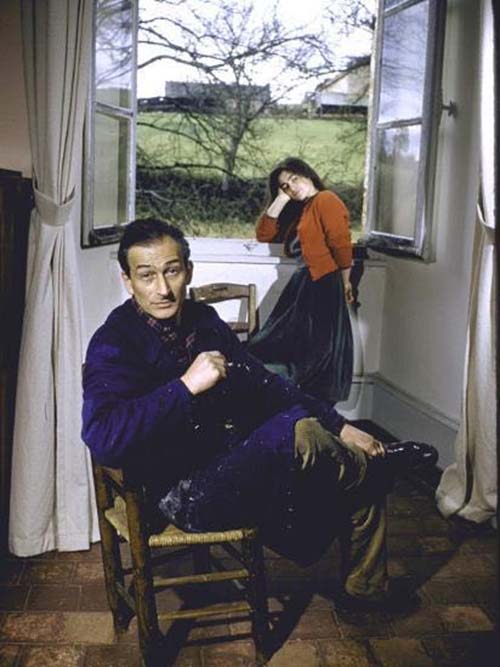
The mystery desires in the art of Balthus
ArtWizard 11.01.2021
“To paint is not to represent, but to penetrate, to go to the heart of the secret, to work in a way to reflect the interior image. The painter is also a mirror. He reflects the mind, the line of interior light … and projects himself towards the dark unbreakable core to draw from it the true identity of the person portrayed.”
Balthus
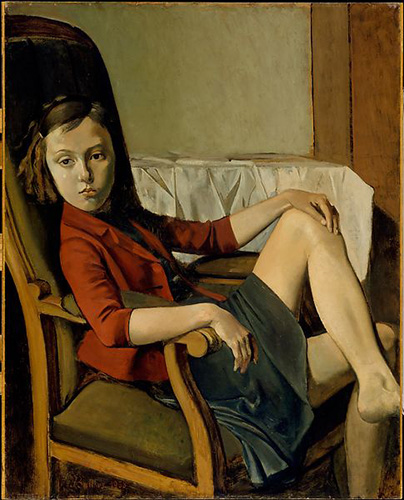
Balthus, Thérèse, 1938
Balthasar Klossowski de Rola, Balthus, is a master of mixing the extremes - a surface tranquillity with predatory desire, innocence with subconscious eroticism. His images contain an infinity of contradictions and mystery. Considered one of the great masters of art of the twentieth century, a very fine painter, he is either loved or detested, with no emotions in between. His paintings show a language of sensual nuances of delimited contours that combine techniques of old masters with some aspects of Surrealism.

Balthus, Fille sur un lit, 1950
What made Balthus somewhat so scandalous that The Met Museum is still arguing, even to the present days, whether to exhibit his paintings, is the main theme of them – the luminous glow of strange emotions called female adolescence. A child prodigy in art himself, Balthus is recognised for his paintings of cats and psychologically provocative and penetrating portraits of young girls on the threshold of puberty.
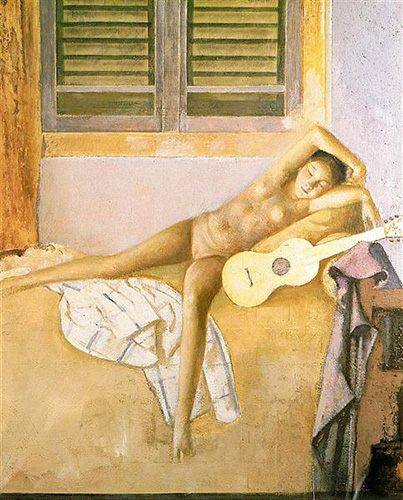
Balthus, Nue avec guitare, 1986
The painter was born in Paris in 1908 in an artistic family of Jewish – Polish origin. His father, Erich Klossowski was an art teacher and historian and his mother, also known as Baladine, was an established painter from a Russian Jewish family. Balthus grew up in a house surrounded by art and artists.
Pierre Bonnard was a friend of his father, while Reiner Maria Rilke was his mother’s lover and subsequently her life companion. Encouraged by Rilke, Balthus went through a long period of self-teaching, spending days in the Louvre copying his favorite old masters – David, Poussin and Chardin. Although he was later influenced by the Surrealists, Balthus was never interested in the avant-garde art movements.
His childhood was disrupted by the beginning of World War I, when his family, being of a German citizenship, had to go back to Germany. The family then moved to Berlin, but not for a long time. His parents separated and his mother moved to Switzerland together with her lover Rilke and the artist and his brother. His mother, Baladine was the illustrator of the poetic books of Rilke, and the latter became the most influential figure and mentor of the young artist.
The first presentation of the works of Balthus was indeed arranged by Rilke, when Balthus was only twelve years old. It was a book with forty ink drawings, depicting his cat Mitsou, a stray cat the artist has taken and loved.
These drawings initiated Balthus lifelong fascination with cats that are represented along with the young girls he liked to depict. The fascination Balthus had for the cats as somewhat unpredictable and mysterious animals is depicted along with the hidden passions of the young girls we find in his paintings.
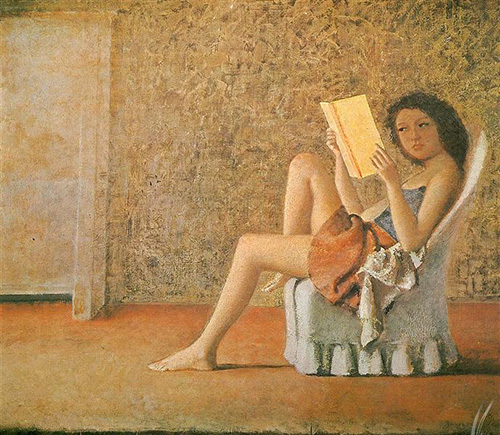
Balthus, Katia lisant, 1974
With the constant support of Rilke, Balthus managed to establish himself as an artist and had his first studio in Paris. The first series of paintings he made was of a young girl named Thérèse Blanchard and her brother and they remain to present days as some of his most widely recognized paintings. Thérèse was a neighbor of Balthus in his atelier at the Cour de Rohan, near the place de L’Odeon in Paris.
Balthus made ten paintings with Thérèse Blanchard, capturing the vulnerability and the willfulness of a girl on the threshold of adolescence. In Girl and Cat / Fille et chat, Thérèse appears self-absorbed, aloof or dreaming, with the cat as her sole companion and playmate.

Balthus, Fille et chat, 1938
In this painting, the young girl is depicted reclining. She is wearing a headband and her knee sosks and sleeves are rolled asymmetrically, her left knee sock falling down, and her left shirt sleeve folded below the elbow. Her pose gives the impression that she has just being called from her play to pose for the paintings. Her skirt rises up too far with her skin depicting as pale with a turquoise tint.
The girl is holding a pose and tenure completely innocent for a child being called out of its play. A fat, placid tiger cat whose expression mirrors her own is at her side. Balthus has imbued Thérèse with an innocent exhibitionism, capturing her in an unguarded moment. Still, many viewers find her pose suggestive. Her hair is short and dark, and her eyes are darker still. A sense of intelligence, and some sense of her stubbornness too, is conveyed in these paintings.
Balthus insisted his paintings of her were not erotic. However, others recognized in them a discomforting sense of a young woman’s emerging sexuality. Balthus however always emphasized his art innocence and referred to the young girls that he painted as “angelic”. The painting Girl and Cat was in 1985, used by the Penguin edition to illustrate the cover of the novel “Lolita” by Vladimir Nabokov.
On this note, Balthus commented for the critics of the New York Times: “I really don’t understand why people see the paintings of girls as Lolita’s. You know why I paint little girls? Little girls are the only creatures today who can be Poussins (Nikolas), pure and timeless. My little model is absolutely untouchable to me. Some American journalist said he found my work pornographic. What does he mean? Advertising with female models is pornographic.”
For the next three years, Balthus painted ten different portraits of young Thérèse in various settings, alone and often daydreaming, sometimes with cats, and sometimes with her brother, Hubert. At this period of his career, the artist was making portraits on commission to earn his money, but he did not seem to be fond of portrait makings. Painting his young neighbor seemed to be a satisfactory artistic activity, as he painted for himself.
As per one of the Met’s press release quotations: “In Balthus’s work, all of the girls who play with cats’ peer into mirrors, read, daydream, or appear completely self-absorbed. Their ostensibly unself-conscious postures sometimes suggest sensuality and languor, sometimes ungainliness, a contradiction that is perfectly natural in keeping with the phenomenon of puberty.”
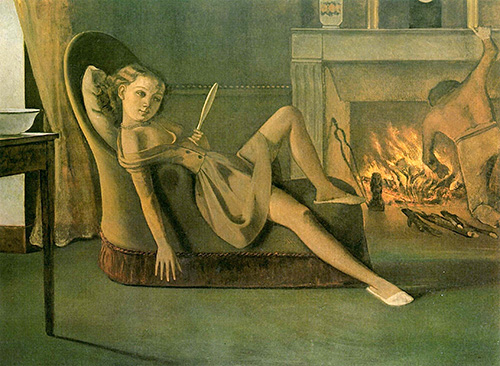
Balthus, Les Beaux Jours, 1944-1946
The Golden Days / Les Beaux Jours as is its original title, an artwork painted between 1944 and 1946, captures one of Thérèse’s successors in a similar pose, as the young Thérèse Blanchard died being only 25 years old.
The young girl on the painting is stretching her nude body on a chair, peering at herself in a mirror as a young boy tends to the fireplace behind her. Her dress falls from her right shoulder and leaves her long legs mostly bare, exposing a great deal of skin, but she seems as unaware of those details as she is of the boy. She narcissistically stares into the mirror, admiring her own youthful beauty. These are, according to Balthus, The Golden Days, the unconscious innocent days of the youth, free of shame, before Eve and the apple, before the fig leaf of decorum covered over the realities of human sexuality. The model stretches out like a self-satisfied, un-self-aware cat.
But besides girls in un-self-aware poses, Balthus painted also plain nude figures, for which he also claimed to be non-erotic, but simply beautiful and angelic. Yet, one can see and feel the beautiful eroticism in them.
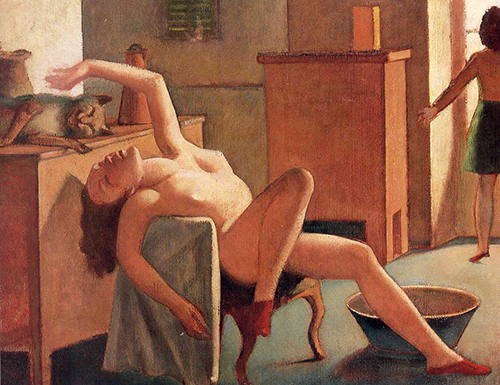
Balthus, Nue avec un Chat, 1949
One of such examples is the painting Nude with Cat / Nue avec un Chat. The painting was made in the Paris studio of Balthus at the Cour de Rohan. However, what is presented on the painting is not the artist studio but an empty room in which have been placed a few props, two rudimentary cupboards without doors, a chair and a basin, a jug, a cat, and two figures. It is a stage, a play that is characteristic of a large number of the interiors of Balthus atelier. This is where the resemblance ends, for this scene can have no before and no after. Every element in the painting is locked in a classical stasis, and if one element moves, everything dissolves.
The paradox is that the nude figure is shown not as immobile but in motion, and, to a lesser extent, the same is true of the figure at the window, standing on tip-toe and extending an arm. The basis of the composition is the division of the rectangle into two triangles, bottom left and top right. Composing the structure of the design on a diagonal comes to show that the artist chooses to begin with a major discord, a method which Balthus frequently employed. Having begun with a figure which is in motion, and in so unstable a position that it must in the next second fall to the floor, the back of the chair already having collapsed, every other element within the rectangle is required to play a direct role in the arrest of this collapse. In this respect Nude with Cat can be seen as a triumph of order over chaos, but also the innocence over the conscious sexuality.
In a review for an exhibition in Paris, Antonin Artaud, a friend of Balthus, wrote about Balthus paintings:
“Balthus paints, primarily, light and form. By the light of a wall, a polished floor, a chair, or an epidermis he invites us to enter into the mystery of a human body. That body has a sex, and that sex makes itself clear to us, with all the asperities that go with it. The nude I have in mind has something harsh about it, something tough, something unyielding, and – there is no gainsaying the fact – something cruel. It is an invitation to lovemaking, but one that does not dissimulate the dangers involved.”
Sales of the nude painting of Balthus were not very large at the time, as people even till present days have a controversial, love or hate opinion about that particular part of the art of Balthus. His reputation grew, however, primarily among fellow artists among which were Joan Miro and Alberto Giacometti, the latter being one of his closest friends.
Another close friend of Balthus, Picasso, bought a significant amount of painting of children themes, most of them made around the year 1937, which he subsequently presented to the Louvre. Picasso appreciated greatly the art of Balthus. In his memoirs he writes about saying to him: “You are the only one of the painters of your generation that interest me. Everyone else wants to be Picasso. You do not.”
Later on, Balthus started to receive some international recognition with a show in the gallery of Pierre Matisse in New York in 1940.
As well as painting children and adolescent female nudes, during his early artistic years, besides painting as a way to support himself financially, Balthus painted some landscapes, street-scenes, still-lives, in fact all the usual subjects for the traditional painter. In addition, which was not so usual, he designed numerous sets and costumes for plays and operas.
In 1949, a few years after painting The Golden Days, Balthus painted a cat-related self-portrait, The Mediterranian Cat / Le Chat de la Méditerranée, in which the artist himself is depicted as a cat, excited and satisfied by a rainbow of fish landing on the plate before him.
A long-haired girl only in a skirt rows a boat behind this Cat-Balthus and waves to the viewer (who originally would have been patrons of La Méditerranée, a restaurant). The rainbow transforming into fish almost emerges from the sea-going girl’s head. Picking from a long menu of possible readings, it is not too much of a stretch to see how the obsession of the artist about young girls fed the other obsession about cats and vice versa.
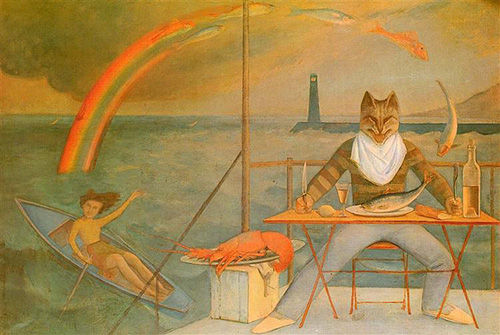
Balthus, Le Chat de la Méditerranée, 1949
Following the invasion of France by the German forces, Balthus fled to Switzerland, returning to France again after the war, settling at the Château de Chassy, situated in Burgundy. He was then joined by another model of his, a 16-year-old girl named Frédérique Tison, who was the artist niece of marriage and became his model.
In the painting Girl at the Window / Jeune fille à la fenêtre, Frederique is depicted from behind as she leans far out of one of Balthus’ studio windows on the second floor at Château de Chassy. Wearing a red pullover and blue skirt, she rests her left knee on a chair to maintain her balance as she leans out the window.
The sunlight highlights the line along the girl’s left shoulder and arm. The window faces west and looks out toward a barn on a nearby hill lit by the sun. The gnarled tree branches are lit in a manner that creates an ornamental lattice in the landscaped screen before her, contrasting with the gray interior.
The painting has none of the suggestiveness many see in Girl with Cat. Instead, it elicits a sense of adolescent longing. The mood is pensive, not melancholic. It reflects the dreaminess of adolescence and emphasizes Balthus’ growing expertise in landscape, however again with a young girl figure present.

Balthus, Jeune fille à la fenêtre, 1955
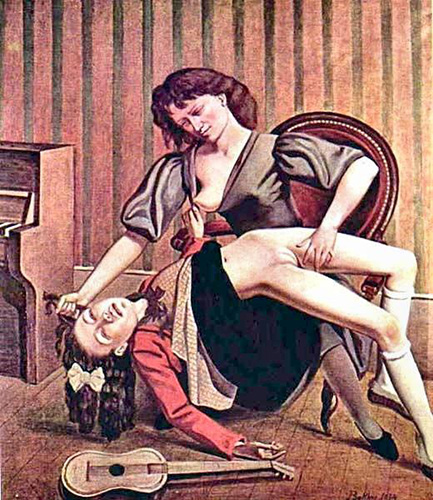
Balthus, La leçon de guitare, 1934
The Guitar Lesson / La leçon de guitare is among the most notorious yet least discussed by the Balthus contemporary critics and friends works. No music is being played in the scene depicted, as the tutorial has turned instead into a sexual initiation rite. Most of Balthus’s writer and poet friends have passed over the work in silence. The composition is considered by some critics as being based on a Pieta, probably the Louvre’s mid-15th-century Pieta of Villeneuve-les-Avignon, to judge from the near identical height and comparable sizes of the figures. In the Guitar Lesson, Balthus depicts a female music teacher holding a young girl across her thighs in lieu of the toy-like musical instrument abandoned on the floor.
The child makes no attempt to struggle. Her body is arching and her posture is somehow evoking the scenes from the lap of the Virgin Mary depicted in the Pieta. Her female teacher’s hands are positioned on the girl as for playing the guitar: one near her inner leg and another holding the young girl hair. Besides containing some exposed part of a nude female body, and of the female body of a very young girl, the painting remains very controversial as some viewers or even critics see an appalling scene of sexual violence, yet other admire the beauty of the composition, the figures and the depiction of still innocent and hidden eroticism. One would say that besides some apparent way to interpreting the scenes of the painting as violent, the delicacy and position of the figures implies a rather innocent game. Such paintings remind all of the art public of why art is sometimes made to make the viewers not only admire, but think, remember and interpret what they see in a painting in very subjective ways, much like some of the old masters liked to hide objects or symbols in the paintings to provoke the imagination observance of the viewers.
The historiography of The Guitar Lesson is as interesting as its subject matter. During the two-week exhibition at the Galerie Pierre, The Guitar Lesson hung in the gallery’s back room, accessible only to a select few. It was only displayed in private for fifteen days. In 1938, the painting was purchased by the art collector James Thrall Soby, who had intended on displaying it, along with his other owned by him artworks at MOMA, but after the museum opted to keep the painting in its vaults rather than on display due to its controversial nature, Soby decided to sell the painting.
The collector exchanged the painting with the Chilean artist Roberto Matta Echaurren in 1945. However, Echaurren’s wife later left him and married Pierre Matisse, the youngest son of Henri Matisse, who owned a gallery in New York, where the painting stayed in the vaults until 1977.
In 1977, the Pierre Matisse gallery exposed the painting for one month, and that caused a such huge media sensation, claiming that this artwork was too shocking to be even shown to the newspaper’s readers at the time. After the Matisse gallery exhibition, the painting was donated to the MOMA in New York, where it was accepted, but also kept in the museum vaults. It was later presented on a private exhibition, in 1982 and again provoked some shocking reactions, including the one of Blanchette Rockefeller, who was so appalled by the painting that she insisted it was given back. From this point in time, the painting was sold again few times, ending in the collection of a Greek collector and then inherited by the heirs of his estate.
Even though this controversial yet very beautiful painting of Balthus has been exhibited only twice for a very short time and in private presentations, it can however be seen as an image on the Internet and it still splits its audience opinion in present days, the reactions ranging from shock and outrage, to more contemplative ones in some social media groups, but always making the viewers to think and polarize their opinions about it.
Balthus paintings made another controversy or it can be called scandal also at the Met Museum in more recent times, in 2017, when the painting Thérèse Dreaming was subject to a petition of a voyeurism complaint. The petition started by a feminist activist demanding the Met Museum to remove the painting Thérèse Dreaming /Thérèse rêvant from its display. The painting is one of the series made by Balthus in 1937-38 depicting the young Thérèse Blanchard.
The petition argued that: “The artist of this painting, Balthus, had a noted infatuation with pubescent girls and this painting is undeniably romanticizing the sexualization of a child ... Given the current climate around sexual assault and allegations that become more public each day, in showcasing this work for the masses, The Met is romanticizing voyeurism and the objectification of children.”
The official records of the Met Museum confirm that the Museum did not decide to remove the painting, despite the fact the online petition that called out the artwork as too sexually suggestive gathered almost 9‘000 supporters, claiming that the painting shall be removed from any public display and only exhibited with a warning sign and in private presentations.
The painting is depicting Balthus’ favored model and neighbor Thérèse Blanchard, reclining in a chair in a carefree pose that leaves her underwear visible, however Balthus and some of his supporters claimed that nothing in this painting suggest any pornographic or sexual context, but only the natural subconscious desires of a young girl. Critics however say that this would be, of course, a universally accepted example of a fine artwork if it wasn't for the fact the girl in question was 12 or 13 years old at the time of the painting's creation.
In this painting, the young girl is presented lost in thought. Sitting in a chair and relaxing, the twelve or thirteen-year-old appears to be alone in a room with a cat. Although the pose in which the girl is depicted does reveal her underwear, there's no other indicator of any sexual context whatsoever.
The answer of the Met Museum is nonetheless interesting as is the petition and provokes real controversy as to what extent an artwork can be censored or not. On this note, Kenneth Weinel, the Chief Communication Officer of the Met Museum stated the following:
“Moment such as this, provides an opportunity for discussion, and visual art is one of the most significant means we have for reflecting on both the past and the present and encouraging the continuing evolution of existing culture through informed conversation and respect for creative expression.”
Despite the discussions, both external and internal, the representatives of the Met Museum decided that they will not include any warning to the masterpiece of Balthus, and they would not remove it from the Met collection and from the public display at the museum.
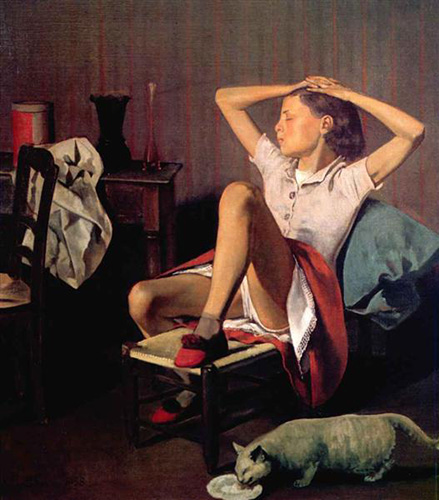
Balthus, Thérèse rêvant, 1938
Balthus’ reclusive way of life ended in 1961, when, at the invitation of André Malraux, the French Minister of Culture, he became director of the French Academy in Rome, Italy, and remained in that position for 16 years. In 1966, he divorced his wife Antoinette and, the following year, married Seksuku Ideta, a Japanese artist in Tokyo, Japan.
Throughout his long and productive life, Balthus completed 350 paintings and 1600 drawings. He passed away at 92 years of age in February 2001. His home was always filled with cats. His last cat, a gift from his daughter Harumi, was named Mitsou II, after the stray cat of his boyhood that launched his career in art.
During the last 30 years of his long life, Balthus was a widely admired painter and stage designer. Following his years in Rome at the French Academy, Balthus secluded himself from the public.
Until the end of his artistic life, Balthus claimed that he needed quiet to work because painting was like prayer for him, saying: “one should die amid the sweet promise of meeting God, in the splendor of which, I’m convinced, painting has always sought to pave the way.”
* Courtesy for all images used to Wikiart.
